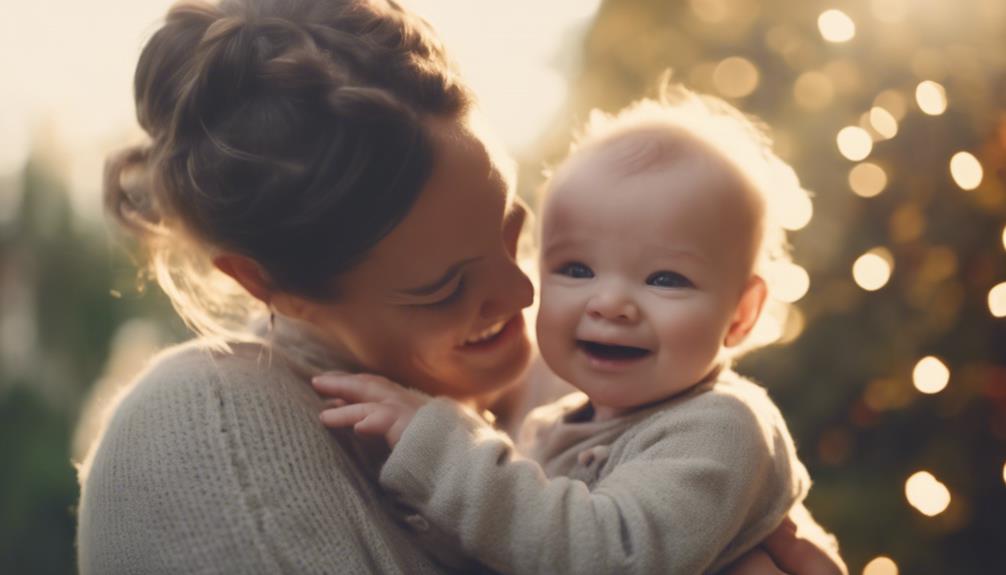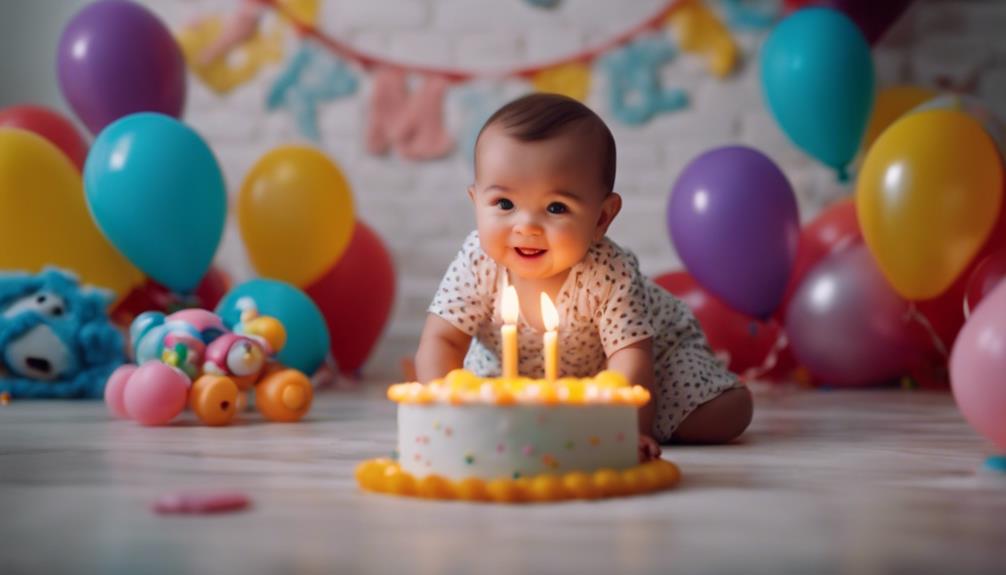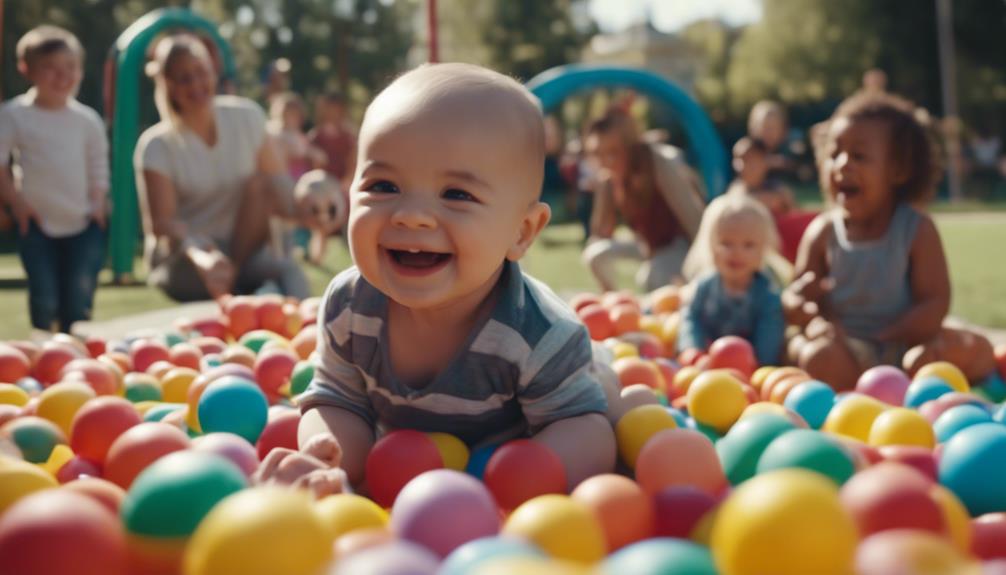Your infant’s happiness can be attributed to factors such as security, routine, and positive interactions. Providing comfort, predictability, and nurturing care helps cultivate joy. Establishing a consistent bedtime schedule and ensuring they get enough sleep also contributes to their well-being. Engaging in activities, positive communication, and physical touch can further enhance their happiness. By forming a strong bond through responsive caregiving and celebrating milestones, you can boost their emotional development. Encouraging socialization and exposing them to new experiences is also important. Creating a happy environment with routines, love, and a nurturing atmosphere is crucial. Practices like swaddling, babywearing, and using soothing sounds to mimic the womb can also contribute to your baby’s happiness. Discover more secrets to your baby’s joy.
Key Takeaways
- Responsive caregiving and consistent routines foster a sense of security and comfort.
- Positive interactions like peek-a-boo and cuddles enhance happiness.
- Celebrating milestones boosts confidence and strengthens parent-child bonds.
- Mimicking the womb environment with swaddling and rhythmic sounds promotes happiness.
- Creating a nurturing environment with lots of hugs and kisses is essential for a happy baby.
Security and Comfort
To guarantee your baby's happiness, prioritize providing a sense of security and comfort through consistent routines and nurturing interactions. At around three months of age, your baby thrives on predictability and stability. Establishing regular feeding, sleeping, and playtime schedules can create a comforting environment that promotes emotional well-being.
Respond promptly to your baby's cues, offering soothing touch, cuddles, and gentle sounds to convey safety and love. Skin-to-skin contact not only fosters a strong bond but also enhances your baby's overall happiness.
Creating a safe, stimulating space where your baby can explore and feel protected is essential for their contentment. Remember, meeting your baby's basic needs, such as feeding, changing, and comforting, lays the foundation for a happy baby.
Healthy Sleep Habits

Having a consistent bedtime routine and ensuring your baby gets enough sleep each night can have a significant impact on their overall happiness.
Establishing a predictable schedule helps your baby feel secure and comfortable, leading to better sleep quality and a more positive mood.
Sleep Duration Impact
Sufficient sleep plays an essential role in shaping your baby's overall well-being and happiness. At around 3 to 6 months old, establishing a consistent sleep schedule is important for your baby's development. Babies who get enough sleep are generally happier, more alert, and better at managing their emotions.
Research from the Netherlands suggests that well-rested babies tend to be more content and less fussy throughout the day. Creating a soothing environment with white noise can also improve your baby's sleep quality and duration.
Knowing when to allow your baby to self-soothe or cry a little can be advantageous for their sleep habits and overall development. By prioritizing your baby's sleep needs and ensuring they get enough rest, you're setting them up for improved mood, cognitive development, and overall well-being.
Consistent Bedtime Routine
Establishing a regular bedtime routine is key to fostering healthy sleep habits for your baby. Consistency in bedtime schedules can significantly impact your baby's happiness and overall well-being. Research indicates that babies thrive on routine, and following a consistent bedtime routine can lead to a more content and cheerful baby. Creating a calming environment by incorporating white noise can help your baby relax and improve their quality of sleep. This sense of security and predictability provided by a well-established bedtime routine can reduce stress levels in your baby, contributing to a happier disposition.
| Benefits of a Consistent Bedtime Routine |
|---|
| Promotes healthier sleep habits |
| Contributes to your baby's happiness |
| Reduces stress levels in your baby |
Positive Interaction and Activities
Engaging in interactive activities with your baby, such as peek-a-boo and singing, can foster a strong bond and promote their happiness. Positive interaction through responsive communication is vital for your baby's emotional well-being. Babies thrive on physical touch, so cuddles and affection play a significant role in their overall happiness. Interactive activities like playing and singing not only stimulate your baby's development but also bring them joy.
Creating a nurturing environment with consistent routines and safe surroundings can enhance your baby's sense of security and happiness. Additionally, socializing with other babies and caregivers can provide valuable opportunities for positive interactions, further promoting your baby's happiness.
Consider joining parenting groups or playdates to give your baby a chance to engage with others and experience different forms of positive interaction. By incorporating these activities into your daily routine, you can help nurture a happy and emotionally healthy baby.
Strong Parent-Child Bonds

To nurture a strong parent-child bond, prioritize skin-to-skin contact and responsive caregiving with your baby. These actions help build trust and security, fostering a deep connection between you and your little one.
When you hold your baby close, engage in eye contact, and respond promptly to their needs, you're laying the foundation for a happy and healthy relationship.
Research shows that babies who experience a secure attachment with their caregivers are more likely to exhibit baby smiles, demonstrate better emotional regulation, and develop stronger social skills.
Milestone Celebrations

Celebrate your baby's milestones to foster happiness and strengthen your bond. Milestone celebrations, like your baby's first smile or first steps, play a significant role in their emotional well-being. Recognizing and commemorating these achievements not only create lasting memories but also boost your baby's confidence and sense of accomplishment. Sharing these special moments with loved ones enhances the joy experienced by your little one. Milestone celebrations provide valuable opportunities for positive reinforcement and encouragement in your baby's development journey.
| Benefits of Milestone Celebrations |
|---|
| Contributes to baby's happiness |
| Strengthens parent-child bond |
| Boosts baby's confidence |
Socialization and New Experiences

Interacting with other babies and exploring new experiences can significantly contribute to your baby's happiness and development. Socialization plays an essential role in your baby's well-being. When your baby gazes at other little ones, they're engaging in important social interactions that can boost their happiness.
Joining parenting groups or arranging playdates can provide your baby with opportunities for new interactions and play, stimulating their curiosity and joy. Exposure to new experiences, such as visits to the park or playing with different toys, can further enhance your baby's development.
Encouraging your baby to explore and try new activities not only fosters a sense of accomplishment but also contributes to their overall happiness. Varied and positive interactions with different people can help in creating a sense of community and support for your baby, ultimately leading to a happier and more fulfilled little one.
Consistent Routines

Exploring consistent routines with your baby can establish a sense of security and predictability, enhancing their overall happiness and well-being. Here are a few reasons why routines play an essential role in your baby's happiness:
- Security Blanket: Routines act as a security blanket for your baby, providing a comforting structure to their day.
- Emotional Stability: Predictable routines help your baby feel emotionally stable, reducing stress and promoting a happier demeanor.
- Quality Sleep: Establishing consistent bedtime and wake-up times can improve your baby's sleep quality, leading to a more content and rested baby.
- Strong Bonding: Following a structured routine fosters a strong bond between you and your baby, as meeting their needs consistently helps them feel secure and connected.
Incorporating consistent routines into your baby's daily life not only benefits their happiness but also contributes to their overall development and well-being.
Nurturing Environment

Creating a nurturing environment for your baby is vital for fostering their happiness and well-being. The early experiences your baby grows up with can have a significant impact on their overall development and contentment. Physical touch, affection, and a safe, stimulating environment are essential components in promoting your baby's happiness.
By responding promptly to your baby's needs and providing them with a comforting and secure environment through cuddling, skin-to-skin contact, and baby massage, you can help reduce their stress levels and strengthen the bond between you and your little one.
Consistent routines, parental responsiveness, and lots of hugs and kisses are key in creating a happy and content baby. Remember, the nurturing environment you create for your baby during their early years can lay a solid foundation for their emotional well-being and happiness as they continue to grow.
Mimicking the Womb

To help your baby feel content and secure, consider mimicking the womb environment for a happier little one. By replicating the sensations experienced in the womb, you can create a soothing and comforting atmosphere that promotes your baby's well-being.
Here's how you can mimic the womb to keep your baby happy:
- Swaddling: Wrapping your baby snugly in a swaddle can provide a sense of security and warmth, reminiscent of the tight space in the womb.
- Babywearing: Carrying your baby close to you in a baby carrier not only promotes bonding but also simulates the gentle movements they felt in utero.
- Rhythmic Sounds: Using white noise machines or gentle shushing sounds can mimic the constant, rhythmic noises your baby heard in the womb.
- Rocking Movements: Rocking your baby gently back and forth can recreate the swaying motions they experienced in the womb, helping to calm and relax them.
Frequently Asked Questions
Why Are Some Babies Super Happy?
You can nurture a super happy baby by responding promptly to their needs, providing love and touch, and creating a safe, consistent environment. These positive experiences shape their emotional well-being, social skills, and overall happiness.
What Does It Mean When Your Baby Is Always Happy?
When your baby is always happy, it typically means their basic needs are met, they feel secure in their environment, and receive plenty of positive interactions and attention. Your loving care and nurturing support are key to their happiness.
What Are the Signs of a Happy Baby?
When your baby's happy, they smile lots, play with enthusiasm, and sleep and eat well. They enjoy cuddles, seek comfort, and show trust in you. Their giggles, curiosity, and contentment reveal their happiness.
Why Do Babies Like Being Surprised?
Babies like being surprised because it triggers their brain's reward center, releasing dopamine for pleasure. Surprises aid in learning cause and effect, boosting cognitive development. The element of surprise captivates their attention, fostering engagement and curiosity.
Conclusion
To sum up, comprehending the reasons behind your baby's happiness can be like discovering a treasure trove of joy. By providing security, healthy sleep habits, positive interactions, and a nurturing environment, you're laying the groundwork for your little one to thrive.
Just like a ray of sunshine on a cloudy day, your efforts to support your baby's well-being will continue to bring happiness and smiles to your family. Keep up the great work!









